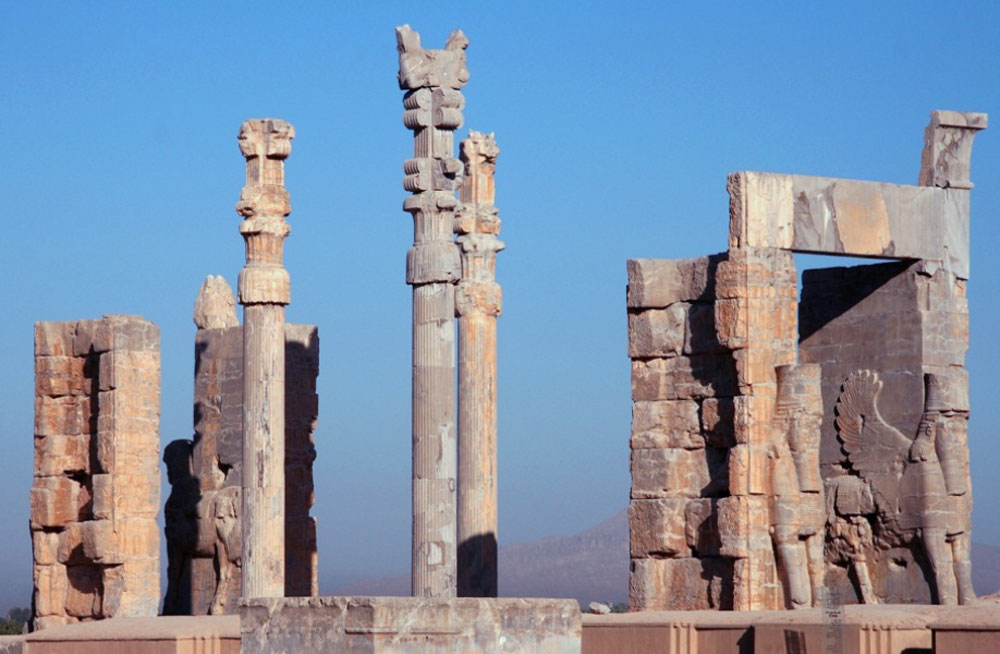
January 6, 2020; Fast Company
Donald Trump is used to playing fast and loose with what others would respect as legal and ethical restrictions, so what are a few violations of international treaties that limit what may be done in armed conflict?
Trump’s latest vow to destroy Iran’s major cultural sites if Iran retaliates against the United States for the killing of General Qassem Soleimani is an outrage of global proportions. As Human Rights Watch points out, that’s an explicit violation of a 1954 treaty called the Hague Convention for the Protection of Cultural Property in the Event of Armed Conflict, which bans attacks on historic buildings, libraries, and museums, among other landmarks. Below is an extended excerpt from a post from Human Rights Watch:
Amid escalating US-Iran tensions following a January 3, 2020 US drone strike in Iraq that killed Qassem Soleimani, commander of Iran’s Islamic Revolutionary Guard Corps Quds Force, Trump tweeted on January 4 that as a warning to Iran, the US has “targeted 52 Iranian sites…some at a very high level & important to Iran & Iranian culture, and those targets, and Iran itself, WILL BE HIT VERY FAST AND VERY HARD.”
“President Trump should publicly reverse his threats against Iran’s cultural property and make clear that he will not authorize nor order war crimes,” said Andrea Prasow, acting Washington director at Human Rights Watch. “The US Defense Department should publicly reaffirm its commitment to abide by the laws of war and comply only with lawful military orders.”
The laws of war prohibit deliberate attacks on civilian objects not being used for military purposes. Objects of great importance to a people’s cultural heritage must not be the object of attack. Article 53 of Protocol I to the Geneva Conventions specifically prohibits any acts of hostility against cultural objects, including making such objects the target of reprisals. The US Law of War Manual (2016), which has extensive provisions relating to the protection of cultural property, incorporates this provision into US law. The US is also a party to the Hague Convention for the Protection of Cultural Property in the Event of Armed Conflict (1954), which similarly prohibits such attacks.
Under customary laws of war, individuals who order or take part in deliberate attacks on civilian objects are committing war crimes. Article 85 of Protocol I specifically states that attacks on cultural objects are grave breaches of the convention. The Rome Statute of the International Criminal Court, to which neither the US nor Iran is a party, includes as a war crime intentionally directing attacks against buildings dedicated to religion, education, art, science, or charitable purposes or historic monuments that are not military objectives.
The US War Crimes statute holds criminally liable US nationals, including officials and military personnel, who commit war crimes. Under customary laws of war, every combatant has a duty to disobey a manifestly unlawful order.
Sign up for our free newsletters
Subscribe to NPQ's newsletters to have our top stories delivered directly to your inbox.
By signing up, you agree to our privacy policy and terms of use, and to receive messages from NPQ and our partners.
But would they? CNN is reporting that Trump’s threat is meeting with at least some resistance in the Pentagon. Rosa Brooks, a law professor at Georgetown, observes that, “In general, there is just enough ambiguity that it’s unrealistic to expect military officers to disobey arguably unlawful orders, but when the commander in chief decides to come right out and say that he’s considering an unlawful order, good news! No more ambiguity.”
Still, relying on generals to disobey orders seems like a dubious strategy to prevent escalation without bounds. Writing in the Washington Post, art critic Philip Kennicott underscores the high stakes: “With his threat to destroy cultural sites in Iran if that country retaliates for the killing of one its top military leaders, the president of the United States has told the world that everything is on the table, including the deliberate targeting of things that bear in them the accumulated emotion and artistry of centuries, things that are invaluable and can never be replaced. And it’s not just a line determined by international law or conventions on the preservation of culture. It is about the soul of a culture or a people, their inmost essence, their fundamental values.” Beyond that, of course, cultural sites are where civilians gather, making this an explicitly terroristic threat.
Michelle Goldberg, an opinion columnist for the New York Times writes that the “unstable and impeached” Trump let us all know who he was early on:
Trump, now impeached and facing trial in the Senate, has laid out his rationale over years of tweets. The president is a master of projection, and his accusations against others are a decent guide to how he himself will behave. He told us, over and over again, that he believed Barack Obama would start a war with Iran to “save face” and because his “poll numbers are in a tailspin” and he needed to “get re-elected.” To Trump, a wag-the-dog war with Iran evidently seemed like a natural move for a president in trouble.
It’s hard to see how this ends without disaster.
But civil society has its ways of creating collective and reciprocal points even in the midst of all of this nightmarish noise. Melody Moezzi, a writer of Persian descent, provides one example in the “Think” opinion section of the NBC News site.
A few hours after Trump’s first tweet, Atieh Sabbar, an Iranian-Canadian designer and HR professional from Toronto, tweeted photos of her paternal hometown of Kashan alongside a call for people to tweet their favorite Iranian cultural sites. Soon after, I joined her #IranianCulturalSites tweetstorm, noting that destroying any cultural site hurts all of humanity, not just a single race or nationality.
—Ruth McCambridge













